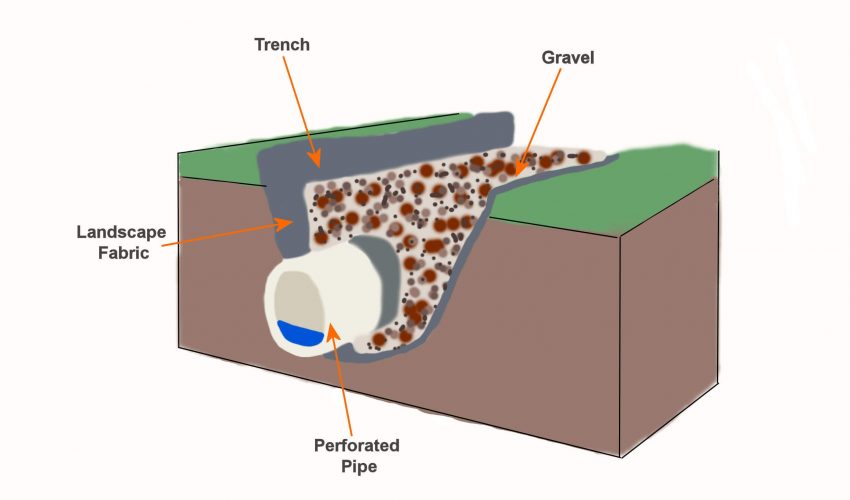When water ends up in places that it shouldn’t be, it can cause a whole lot of problems. Soggy backyards and soil saturated with water against the foundation of your home can lead to wet basements and thousands of dollars in repairs. One common way to deal with this is to have a drainage system installed known as a French drain.
What is a French drain?
French drains are a drainage system used to manage water. They are very effective at rerouting water. French drains prevent the soil from becoming oversaturated by taking the excess water and dispersing it at an acceptable location, away from the area you want to protect. It is a simple concept, although a fair amount of work to install. It consists of digging a trench and placing a perforated pipe inside that is surrounded by gravel.
Many also call French drains “weeping tile.” They can generally be used interchangeably, however if being technical, there is a slight difference. French drains are normally placed right under the surface while weeping tile is in fact a type of French drain that is meant to protect a building’s foundation and so the pipe is installed much deeper down, next to the foundation’s footings.
How does a French drain work?
French drains rely on gravity and the right slope. As you certainly already know, water will always run downhill and will choose the path with the least amount of resistance. The gravel surrounding the perforated pipe allows the water to more easily pass through and so this becomes the path of least resistance, ensuring that the water will be drawn from the soil and into the perforated pipe.
The grading is vital for French drains and will not work properly if this is not done correctly. The slope of the pipe will allow the water to be moved by gravity in the direction of the discharge location. If the grading is not right the water will not be able to move efficiently in the correct direction.
The discharge point will vary depending on the best determined location for the unique property. Just be sure that it is far enough away from the area that you are trying to keep from becoming waterlogged. Normally a good location is a dry well, a drainage ditch, a street or a low-laying spot on the property. Also, it is important to note that most cities have laws on where you can place the discharge and so these should be checked to guarantee that you do not have any problems with the placement. For weeping tile systems, they often are discharged into a sump pump located in the home’s basement.
How do I know I need a French drain?
A French drain will be highly beneficial if you are a homeowner experiencing a waterlogged backyard and/or a wet basement. French drains will effectively eliminate surface water from accumulating in your yard so you are not dealing with a soggy lawn for hours or days after a rainfall or problems occurring from soil erosion. They also protect your home from hydrostatic pressure caused by saturated soil around your foundation which can lead to wet basement problems.
Furthermore, if you are building a retaining wall on a hillside a French drain is necessary. This is because water flowing downhill will build up behind the wall and the pressure will eventually cause the structural integrity to be compromised.
French drains are well worth the invested money and can spare you from many problems popping up due to water saturated soil and erosion. WaterPro Master is experienced and ready to help. We always welcome any question that you may have and offer free, no obligation quotations in Toronto and the GTA.

